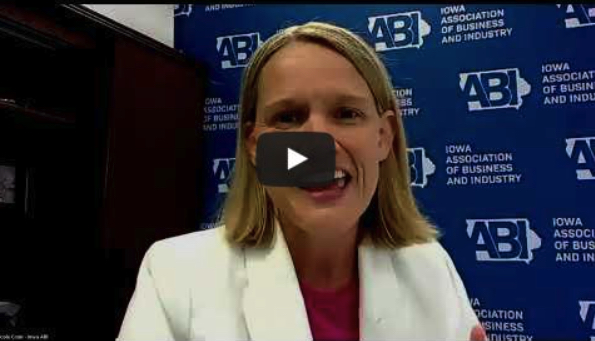Record-high diesel prices add to headwinds for manufacturers, carriers
Companies wrangle with seesawing demand, inflationary pressures

Every business day at Van Gorp Corp. in Pella, pallets of conveyor assemblies, pulleys and other parts manufactured there are trucked out to customers across the United States and numerous other countries, primarily in the Western Hemisphere.
The manufacturing company, founded in 1933, specializes in supplying engineered conveyor system components. Van Gorp’s customers include a broad range of industries, from agricultural processors that use all types of conveyors for produce and grain handling applications to mining and energy companies that use its conveyor pulleys to move ore and coal.
Fuel and freight costs are an increasing concern for manufacturers and logistics companies that transport raw materials and finished goods to and from manufacturing plants. The per-mile cost of hauling freight has nearly doubled over the past five years.
At Van Gorp’s operation in Pella, total transportation costs have increased by as much as 25% in the past year, said Joe Canfield, the company’s owner and CEO.
As a percentage of total costs, transportation expenses account for about 7% of the company’s budget, considering both the costs of shipping goods by truck domestically and via container ships internationally.
“When I look at the baseline of incoming costs for freight, the [fuel] surcharge is what’s really starting to add up for me,” Canfield said. Fuel surcharges are typically added on to freight contracts on top of the negotiated rate to protect the carriers from the effects of volatile markets.
And on outbound freight for shipping out finished products, “we have some customers with negotiated contracts, longer-term contracts where we provide the product prepaid, so we pay the freight going to those customers. And that really starts to impact the profit margin that we’re making on those accounts.”
As of mid-May, diesel prices nationally were averaging $5.62 per gallon, a 171% increase from the average price a year ago and a 244% increase from the average in 2016, according to data from the U.S. Energy Information Administration.
“The lion’s share of the movement has been in the last 12 months or so,” said Jeremy Spillman, CEO of Toggle Inc.
The Des Moines-based software startup company he founded is currently testing a blockchain-driven digital freight management system it developed, with a goal of driving new efficiencies into how independent carriers operate. Spillman’s team of third-party logistics experts have long-term relationships with shippers that include Van Gorp, as well as small independent trucking companies across the United States.
The significant spike in diesel prices has nearly doubled the cost per mile for freight compared with five years ago, Spillman said.
“So when you’re breaking down the cost for a truck to be on the road, what used to cost 35 cents a mile in 2016 is now costing just over 86 cents a mile,” he said. “That equates to probably an extra $300 just in fuel costs on a 1,000-mile run. So obviously you’re seeing a lot of pressure going to the driver and how to reconcile this and how to charge efficiently.”
There are two different markets for shippers: the spot market, in which they’re engaging for freight services at current pricing, and the contract market, in which a shipper locks in a “dedicated lane” for regular shipments for a set period of months. Fuel surcharges are imposed in conjunction with contract rates to make up for market differences from the time the contract was set.
“If you have inflated costs in fuel, ultimately the person holding the bag for it is going to be the shipper or the consumer,” Spillman said. “The shipper is going to take the brunt of that initially, but then they’re going to pass that cost on to their consumers who are buying the product. … We are seeing that domino effect kind of trickle through the markets right now.”
While manufacturers used to be able to request a one-year contract, “right now it’s so volatile that carriers are pushing back, saying, ‘I can give you three months — that’s it,’ “ he said. “There is so much volatility out there that even the fuel surcharges don’t seem to be taking care of all of the costs associated with what we’re seeing in the supply chain breakdown.”
Much of the price volatility has been driven by surges and lulls in freight movements over the past months, Spillman noted.
“We saw a huge ramp-up in available freight to move last summer, and now obviously we’ve cleared the congestion off the West Coast,” he said. “Now, with the [COVID] lockdowns in Asia, you’re starting to see all those ships stack up waiting for pickup.
“So even if the fuel costs are high, the supply of product to move is down because of what we’re seeing in Asia,” Spillman said. “So you have these two things really working in gridlock with each other. This is that pendulum that’s going to continue to swing back and forth and cause a lot of heartache and headache for shippers for the foreseeable future.”
The American Trucking Associations track tonnage figures for U.S. freight transportation on a monthly basis. On average, trucking carriers handle 72.5% of tonnage carried by all modes of domestic freight transportation, including manufactured and retail goods, according to the ATA.
The ATA’s most recent For-Hire Truck Tonnage Index, which is seasonally adjusted, decreased 2% in April after rising 1.8% in March. In April the index equaled 115.8, versus 118.2 in March. (In the index, 100 equals the 2015 average level.)
“After eight straight gains totaling 6.9%, for-hire tonnage finally slid back in April,” said Bob Costello, the association’s chief economist. “Despite being the largest sequential drop since August 2020, the index was still above where it started in 2022 and a year earlier.”
In a press statement in late May, Costello said the market is transitioning back to pre-pandemic levels of contract shipments as compared with the spot market. “While I expect contract freight to outperform spot market freight, the rate of growth will be slower than in 2021. Most contract carriers are still struggling with maintaining enough capacity, both equipment and drivers.”
Asked if price volatility could put some smaller carriers out of business, Spillman said demand volatility is the biggest threat.
“I would say the thing that could jeopardize the existence of smaller trucking companies right now is how freight is drying up in the short term because of the lack of supply coming in from Asia,” he said. “And then in a few months once they get all the ships filled up and they come back, then we get walloped all over again. So the truckers are going to ask for an even higher amount this next round because they don’t know what the next swing is going to look like. That’s what’s going to continue to drive costs even higher outside of the rising fuel costs.”
From Canfield’s perspective at Van Gorp, high freight costs are “just one more thing” on top of a host of higher operational costs.
“It costs more money every day to hire labor, and so every facet of the business is seeing inflation,” he said. “We’re trying to account for that in our cost strategy and how we price things moving forward. It was a trick last year because pricing was changing so fast. The ink wouldn’t be dry on the quote paperwork and you’d almost have to recalculate again [if the order was changed] because prices were changing so fast.”
Van Gorp had been absorbing fuel surcharge increases, Canfield said, “but lately, we have found that we can no longer do that. And so we’re having a lot of difficult conversations with customers, explaining that not only do we have to raise prices for these other items, such as the actual cost of the materials, but we’re also having to factor in the cost for fuel surcharges and freight.”
Some customers in response have begun to delay proceeding on contracts for replacing their conveyor systems, and a few companies have indefinitely postponed projects, he said.
“We still have a very strong backlog,” Canfield said, noting that to handle its current orders, the company expects to increase its workforce, currently at 70 workers, by about 10 additional employees. “However, we’re starting to see that type of conversation, and that’s really popped up to be more prevalent in the last two to three months.”
Asked about strategies for mitigating higher costs, Canfield said his company is factoring greater shipping delays into its inventory calculations to carry more inventory to cover longer replenishment windows. “Obviously, our procurement department is very busy continuously trying to source product and find new stable sources, and that is a challenge because there’s such a lack of inventory within the supply chain,” he said.
Onshoring more raw materials from North American suppliers rather than from overseas is a consideration, but a challenging one, Canfield said. “When we talk to many suppliers, they echo those same sentiments about workforce shortages, raw material challenges and inflation, all of those similar constraints that we’re facing.”
Regional economic indicator shows high inflationary pressures
The Creighton University Mid-America Business Conditions Index, a leading economic indicator for a nine-state region of the Midwest including Iowa, shows the region continues to add manufacturing activity at a healthy pace, but with significant inflationary pressures.
The April index measured at 65.9, down from 71.3 in March. The index has tracked a growing economy — numbers above 50 on a zero to 100 scale — for 23 consecutive months. The Business Conditions Index is a mathematical average of indexes for new orders, production or sales, employment, inventories, and delivery lead time.
Within the survey, Iowa’s Business Conditions Index in April decreased to 69.8 in April, down from 76.6 in March.
More than half of survey participants across the nine states — 56.7% — reported that the rising costs of materials for suppliers was the prime factor pushing input prices higher. Approximately 13.5% named transportation delays as the prime factor driving input prices higher, while 10% and 6.7% identified higher fuel energy prices and labor costs, respectively, as factors pushing input prices higher. The remaining 13.1% named other factors, such as supplier profits, as causes of higher input
The wholesale inflation gauge for the month declined to a still high 89.7 from March’s supercharged 95.5.
“Creighton’s monthly survey continues to track the highest and most consistent inflationary pressures at the wholesale level in more than a quarter of a century of conducting the survey,” said Ernie Goss, the Jack A. MacAllister chair in regional economics at Creighton.
Only two of 10 supply managers surveyed expected improvements in supply chain disruptions in the next six months. Also, concerns about the impacts of higher interest rates and soaring inflation pushed economic confidence well below growth-neutral — to 31.7 — an improvement from a record-low 19.5 in February.










